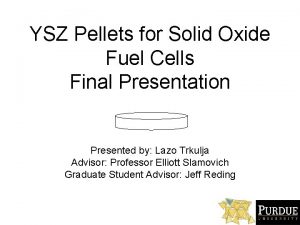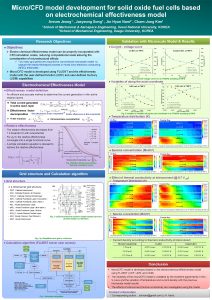MicroCFD model development for solid oxide fuel cells

- Slides: 1

Micro/CFD model development for solid oxide fuel cells based on electrochemical effectiveness model Areum Jeong 1 , Jaeyeung Song 1 , Jin Hyun Nam 2*, Charn-Jung Kim 1 1 School of Mechanical & Aerospace Engineering, Seoul National University, KOREA 2 School of Mechanical Engineering, Daegu University, KOREA Validation with Microscale Model & Results Research Objectives Current - voltage curve Objectives Ø Electro chemical effectiveness model can be properly incorporated with CFD simulation codes, reducing computational costs allowing the consideration of microstructural effects ü Too many grid points are required for conventional microscale model to capture the reaction/transport process in mixed ionic-electronic conducting (MIEC) electrodes Ø Micro/CFD model is developed using FLUENT and the effectiveness model with the user-defined function (UDF) and user-defined memory (UDM) capabilities Electrochemical Effectiveness Model Fig. 4 Current-voltage curves for an IT-SOFC operating at 700°C Variables of along the axial coordinate Effectiveness model definition - An efficient and accurate method to determine the current generation in thin active reaction layers v Total current generated in active react. layer v Effectiveness factor decomposition Base effectiveness at zero overpotential v Thiele modulus Relative effectiveness at finite overpotential v Dimensionless overpotential Fig. 5 Variation of variables along the axial coordinate in an IT-SOFC operating at 700°C Temperature distribution (K) Co-flow Counter-flow Relative effectiveness - The relative effectiveness decreases from 1. 0 towards 0. 0 with overpotential - For T>3, the relative effectiveness converges into a single functional curve - A simple correlation equation is devised to retrieve the relative effectiveness Fig. 6 (a) Temperature distribution in an IT-SOFC operating at 700°C Fig. 6 (b) Temperature distribution in an IT-SOFC operating at 700°C Species concentration (Mol/m 3) Co-flow Counter-flow Fig. 7 (a) Species concentration in an IT-SOFC operating at 700°C Fig. 7 (b) Species concentration in an IT-SOFC operating at 700°C Fig. 1 Relative effectiveness factors: Data and correlation curves Grid structure and Calculation algorithm Grid structure Effect of thermal conductivity at interconnect (@ 0. 7 Vcell) ü Temperature Distribution (K) Co-flow Counter-flow 0. 7 Ø 2 -dimensional grid structure - CINT : Cathode interconnect - CCH : Cathode Channel ( Air Channel ) - CCH_C : Cathode Channel Contact layer - d. CFL : Cathode Functional Layer ( Non-active ) - a. CFL : Cathode Functional Layer ( Active ) - ASL : Anode Substructure Layer - d. AFL : Anode Functional Layer ( Non-active ) - a. AFL : Anode Functional Layer ( Active ) Fig. 8 (a) Temperature distribution in an IT-SOFC operating at 700°C - ACH_C : Anode Channel Contact Layer ü Species concentration (Mol/m 3) - ACH : Anode Channel ( Fuel Channel ) - AINT : Anode Interconnect Fig. 2 (a) Electrochemical reaction/ charge transport process (b) Grid number in y-direction Co-flow Counter-flow Fig. 9 (a) Species concentration in an IT-SOFC operating at 700°C Fig. 2 (c) Simplified mesh grid in x-direction Calculation algorithm (FLUENT solver user access) Fig. 8 (b) Temperature distribution in an IT-SOFC operating at 700°C Fig. 9 (b) Species concentration in an IT-SOFC operating at 700°C ü Current density according to thermal conductivity at interconnect Thermal conductivity Co-flow Counter-flow 5 W/m-K 0. 870 A/cm 2 1259. 20 K 0. 920 A/cm 2 1307. 33 K 25 W/m-K 0. 902 A/cm 2 1258. 95 K 0. 952 A/cm 2 1299. 81 K 125 W/m-K 0. 930 A/cm 2 1242. 59 K 0. 965 A/cm 2 1281. 54 K Conclusion § Micro/CFD model is developed based on the electrochemical effectiveness model using FLUENT (UDF, UDS, and UDM) § The reliability of the micro/CFD model is validated by the excellent agreements in the IV curve and the variation of temperature and current density with the previous microscale model results § The effects of interconnect thermal conductivity are investigated using the model Contact information Fig. 3 Calculation Algorithm * Corresponding author. jinhnam@gmail. com (J. H. Nam).

